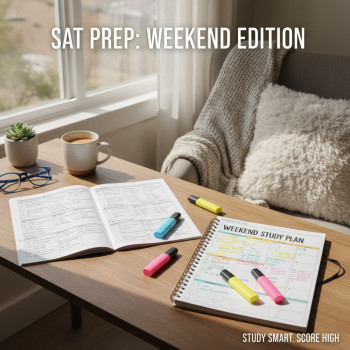What are percentiles — in plain English?
If you’ve ever scanned an SAT score report and seen a number like “78th percentile” next to your Total score, you might have felt a tiny thrill — or a knot of confusion. Percentiles aren’t fancy math for the elite. They’re a straightforward way to say how your score compares to other students. The 78th percentile means you scored the same as or better than 78% of the comparison group. Simple. Powerful. And incredibly useful — if you know how to use it.
Why percentiles matter more than you think
Raw scores (how many questions you got right) and scaled scores (the familiar 400–1600 total on the SAT) tell you what you scored. Percentiles tell you what that score means in context. Two students with the same scaled score could face different realities depending on how colleges, scholarship programs, or your school interpret those percentiles.
Percentiles help in three big ways:
- Comparison: They show where you stand among peers (nationally, by state, or among all testers).
- Goal-setting: They translate vague hopes (“I want to be competitive”) into clear targets (“Aim for the 90th percentile”).
- Decision-making: They inform which colleges are realistic, reach, or safety choices based on historical applicant pools.
Percentile vs. Percent — don’t get them mixed up
A common slip-up: confusing a percentile with a percent score. If you answered 70% of questions correctly, that’s not the same as being in the 70th percentile. Percent is a measure of correctness; percentile is a comparison to other test takers.
Think of percentiles like ranks in a race. Finishing in the 90th percentile is like being in the top 10% of finishers — not that you ran 90% of the race. Once you grasp that, reading score reports becomes less of a puzzle and more of a tool.
Which comparison groups are used?
Percentiles can be reported using different groups, so always check which one you’re looking at. The most common groups on digital SAT reports include:
- All Testers (everyone who took the test in a given period)
- Nationally Representative Sample (used to compare against a statistically weighted sample)
- State or Country percentiles (useful if you want a regional benchmark)
Each group answers a slightly different question. “All Testers” lets you see how you stack up against everyone who took the SAT recently. “Nationally Representative Sample” helps correct for who actually took the test and produces a stable comparison. State percentiles show how you compare with students in your state — handy when colleges give weight to in-state achievement or when scholarship pools are state-driven.
How percentiles relate to scaled scores — a practical example
Scaled scores translate your raw correct answers into the familiar 200–800 section scores and 400–1600 total. Percentiles then place that scaled score in context. Consider these hypothetical mappings — they’re simplified but illustrate the idea:
| Scaled Score (Total) | Approximate Percentile | What it suggests |
|---|---|---|
| 1500+ | 98th–99th percentile | Exceptional — among top test takers nationally |
| 1300–1490 | 82nd–97th percentile | Very strong — competitive for many selective colleges |
| 1100–1290 | 46th–81st percentile | Solid — opens doors at many institutions, good scholarship potential |
| 900–1090 | 16th–45th percentile | Below average to average — clear room for strategic improvement |
| <900 | <16th percentile | Significant improvement possible with structured prep |
Note: This table is an illustrative tool to help you think in percentiles; actual percentile cutoffs can shift slightly by testing cycle and reporting method. Always check the percentile labels on your official score report to see which comparison group is being used.
Why percentiles can shift even if your score doesn’t
Percentiles are relative, which means they depend on other students’ performance. If a particularly strong cohort takes the test in one season, percentiles can shift. That’s why a 1250 might be the 70th percentile one year and the 68th the next. The key takeaway: don’t treat percentiles as fixed stamps — they’re a moving reflection of the test-taking population.
Real-world analogy
Imagine school gym tests where everyone runs a mile. If most students train hard one year, the finish-line times improve and your percentile could slip without you changing your time. On the SAT, practice, curricula, and who signs up to take the test can all affect cohort performance.
How colleges actually use percentiles
Admissions teams look at many things — GPA, essays, recommendations, extracurriculars, and test scores. Percentiles help admissions officers quickly place your SAT score against the broader applicant pool. A high percentile signals strong standardized-test performance; a middle percentile doesn’t close doors but clarifies where your application fits.
Some scholarship programs and state merit awards use percentile thresholds to determine eligibility. That’s why knowing whether you’re in the top 10%, 25%, or 50% can have direct financial consequences.
Using percentiles to set study targets
Percentiles are excellent goal-setting tools. Rather than a vague aim — “get better” — target the percentile that aligns with your college list and scholarship hopes. Here’s a simple process:
- Choose your target colleges and identify their test score medians or ranges.
- Translate those target scores into percentiles using your latest score report or an illustrative mapping.
- Set incremental goals (e.g., move from 60th to 75th percentile over three months).
- Create a study plan that focuses on high-impact weaknesses (e.g., geometry or evidence-based reading strategies).
For many students, moving a section score by 40–80 scaled points can shift percentiles dramatically. That movement often comes from targeted practice rather than sheer volume of studying.
How to interpret section percentiles
College Board typically shows percentiles for the Total score and for each section (Evidence-Based Reading and Writing, Math). Section percentiles can reveal where you’re relatively stronger or weaker compared to peers — and they often show the biggest opportunities for score gains.
- If your Math percentile is much higher than your EBRW percentile, focus on reading strategies and grammar conventions to lift your EBRW score.
- If both section percentiles are similar, balanced practice across sections will help raise your Total percentile.
Concrete example — Alex and Jordan
Alex scored a 1320 and is in the 86th percentile. Jordan scored a 1320 as well, but in a different season and is in the 83rd percentile. Both scores are identical, but Alex and Jordan may draw slightly different conclusions:
- Alex might find his 86th percentile opens doors for merit scholarships that use that threshold.
- Jordan should still be encouraged — a 1320 is strong — but might set a realistic target of 1350 to be safely within his desired percentile range if he wants the same scholarship opportunities.
Both students benefit from tailored plans: Alex from consolidating skills to maintain his percentile, Jordan from targeted practice to regain or improve his standing. That’s where personalized tutoring — for example, Sparkl’s 1-on-1 guidance with tailored study plans and expert tutors — can fit naturally. A tutor who reads percentiles and tracks practice-test cohorts can help you move the needle efficiently.
How many points usually moves you up a percentile?
There’s no universal answer because percentiles depend on the cohort. However, some practical patterns emerge:
- At the middle of the distribution (roughly 1000–1250), small gains — 20–40 points — can move you several percentile points.
- At the top end (1400+), even 10–20 points might not change percentiles much because many students cluster there; percentile movement is slower.
- At the low end, larger point gains might be needed to climb percentiles because the distribution is denser in some ranges.
So, don’t measure progress only by points. Track percentiles week-to-week with realistic practice tests to see how your improvements stack up against the broader pool.
Practical study plan tied to percentiles
Here’s a compact 8-week plan that ties actions directly to percentile goals:
- Week 1–2: Diagnostic test and percentile baseline. Identify weakest subskills and create a 3-topic weekly rotation.
- Week 3–4: Targeted practice on weaknesses (timed sections twice a week). Track section percentiles after each full-length test.
- Week 5: Midpoint mock test and review — adjust plan based on percentile shifts.
- Week 6–7: Intensive strategy refinement (data-driven practice, error logs, and targeted drills).
- Week 8: Final mock tests, test-day routines, and percentile-focused review (practice at the same time of day as test day).
If you prefer guided help, Sparkl’s personalized tutoring packages pair students with tutors who design plans like this and use AI-driven insights to highlight the most efficient study moves. A guided plan helps keep percentile targets realistic and actionable.
Common percentile misconceptions
- Misconception: “Higher percentile always means better chance at any college.” Reality: Percentiles matter, but colleges weigh multiple components — GPA, essays, and fit can be decisive.
- Misconception: “A small point increase won’t change anything.” Reality: In the middle ranges, small point gains can shift percentiles significantly and impact scholarship eligibility.
- Misconception: “Percentiles are identical across paper and digital tests.” Reality: Reporting groups and sample methods can differ slightly; always check which comparison is used on your report.
How to present percentiles on college applications and conversations
When discussing your scores with counselors, teachers, or in interviews, use percentiles to add context: say “I’m in the 85th percentile nationally” instead of only stating the scaled score. It’s clearer and more meaningful to listeners who aren’t immersed in test-score scales.
Quick checklist before test day — percentile-minded
- Know your current percentiles and target percentiles for your college list.
- Practice full-length digital practice tests under realistic conditions (device, timing).
- Focus on high-leverage weak spots that will move section percentiles quickly.
- Simulate test day energy: timing, breaks, and device setup.

Interpreting percentile movement after multiple tests
If you take multiple tests, compare percentiles across the same comparison group (e.g., All Testers). That keeps your comparisons fair. If your percentile is climbing steadily across real tests and high-quality practice tests, you’re making real progress. If it’s fluctuating, look at the test conditions, fatigue, and whether your practice tests are representative.
How institutions sometimes report percentiles differently
Some schools or programs will quote SAT medians for admitted students rather than percentiles. To translate, find where those medians fall in national percentiles on your score report or in your test prep resources. Medians show the midpoint of admitted students’ scores and can help you understand selectivity beyond percentiles.
Using percentiles to prioritize time and money
Not all improvements are equally efficient. If you need to move from the 60th to the 80th percentile, targeted tutoring on a few weak content areas could be far more efficient than blanket practice. Personalized tutoring (like Sparkl’s tailored study plans and expert tutors) can direct your study hours where they’ll shift percentiles the fastest — often a better investment than simply increasing total study time.
Summary: The percentile mindset
Percentiles are more than numbers — they’re a way to see yourself relative to the crowd and make smarter choices. Think of them as a compass for study plans, college lists, and scholarship hunting. Use percentiles to set concrete goals, measure meaningful progress, and decide when to seek focused help. If you pair percentile awareness with targeted practice and occasional expert feedback, you’ll turn abstract goals into real results.
Final practical tips
- Always check which comparison group your percentile uses.
- Use section percentiles to find the most efficient levers for improvement.
- Track percentiles across several high-quality practice tests for a reliable trend.
- If you’re aiming for scholarships or selective programs, map their thresholds to percentiles — it clarifies your target score.
Percentiles give context to your effort, and context is what turns practice into strategy. Keep them in your toolkit as you plan the next step — whether that’s a focused two-month prep sprint or a slower, steady build. If you want a more individualized plan, tutors who understand percentiles and test data can help you target the highest-impact areas — an approach Sparkl’s personalized tutoring emphasizes with 1-on-1 guidance, tailored study plans, and AI-driven insights. Good luck — and remember: percentiles are a map, not a verdict. Use the map to choose your route, practice smartly, and enjoy the journey.

















No Comments
Leave a comment Cancel